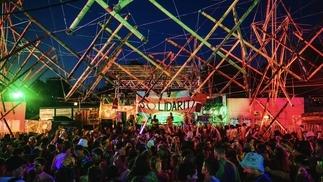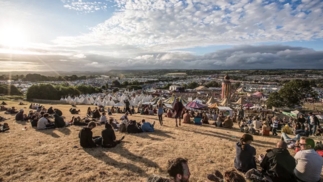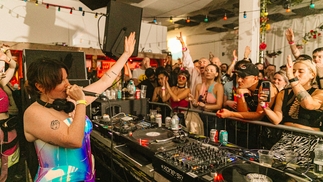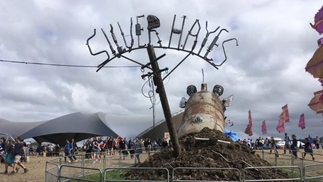Inside Glastonbury’s Block9, the festival world’s wildest clubbing space
Deep, down and dirty at Worthy Farm’s sexy psychedelic playground...

This month, one of the world’s wildest clubbing spaces opens its doors again — for one long weekend only. The temporary queer autonomous zone that is the Block9 field at Glastonbury Festival — comprising the amazing NYC Downlow, Genosys and London Underground venues, plus more besides — celebrates its 10th anniversary this year. DJ Mag meets the team behind the madness...
It’s Friday night at Glastonbury in 2010, and the first-time veteran house selector Tristan da Cunha has walked in to the NYC Downlow at the festival. In the booth, Hannah Holland is laying down oldschool New York house that sounds like it was lifted straight out of the city’s iconic Sound Factory, flanked by the club’s technicolour drag troupe, who litter the stage at the front of the venue. After being hit by the intense heat of the party, da Cunha looks around at Glastonbury’s dark underbelly, and sees an X-rated disco careering willfully out of control.

“It’s a fantasy land,” he tells DJ Mag just weeks before he’s set to spin at the Downlow this year. “And something that’s beyond the imagination. I’ve been DJing for a good 20 years, so I’ve seen a lot of parties, but it really knocked me back. I was instantly hooked. It’s dark and sweaty, and has that sense that a moment could explode at any point — it still blows me away every time I go.
“There’s a freedom in the Downlow that you can be who you want to be, and do exactly what you want to do, and nobody will judge you. That’s rare now. When you get there, you’ve got to just go for it, and it’s a wet dream for a DJ to play somewhere like that.”
Only three years before da Cunha’s first visit, Gideon Berger and his creative partner Stephen Gallagher, otherwise known as set designers Block9, were given £2,000 by the team behind now defunct Glastonbury late-night field Trash City to build the festival’s first gay venue. In the 10 years since, the duo and their team have steadily built their small corner of Glastonbury into one of its biggest attractions, starting with the NYC Downlow in 2007.

Sexy, sleazy, lawless and wild, it’s like every great night out you barely remember, a ravaging beast of a no-holds-barred club, and the antidote to all-toooften formulaic modern-day city clubbing. Originally based in a disco-era New York’s Lower East Side, it’s packed from start to finish for the one weekend it’s open a year, and a fleeting reminder of exactly what you want from a party amidst a world of conformity.
“We blagged every fucker we’d ever met for anything we could,” Berger says of the first year. “A pot of paint, wood, some diesel for the truck, a tent, the soundsystem, decks, a DJ set: literally anything. Back then we did everything ourselves too; making tea, sweeping workshops, loading trucks, playing records and cooking the crew lunch, but with next to no money and a lot of love, a motley crew of us with a communist pipedream rocked up at Glastonbury and built the Downlow.”
As history shows, they’ve never looked back since. DJ Mag meets Berger and Gallagher at their east London design studio just weeks before they head on site at Glastonbury to prepare to celebrate their 10th anniversary, but a lot’s changed. Through the course of a decade, NYC Downlow has come to sit in its own Block9 field — a psychedelic playground that also includes The London Underground, Genosys, Maceo’s and the Meat Rack, each a venue with its own story and musical dialogue.

The Block9 team have also done stage production for Skrillex and Lana Del Rey in recent years, designed the castle at Banksy’s Dismaland theme park, and partnered with The Roundhouse theatre in London. As well as their annual shindig at Worthy Farm in 2017, they’re also production designers for the Gorillaz ‘Humanz’ live show, set designers for the illustrated band’s Demon Dayz festival (also in June), and commence work on their long-planned touring production that’s set to break Block9 out of its Somerset field and into major cities worldwide.
“Ten years down the line and the trajectory of Block9 is going towards the stars at an alarming rate,” Berger beams. “The field at Glastonbury works as a 360-degree Block9 design, and we keep upping our game, wanting to out-do ourselves and every other fucker that’s trying to catch up with us at other festivals.”
And he isn’t wrong. Having introduced the London Underground in 2010, which Berger describes as the “older, straighter, slightly more ASBO-y big brother of the Downlow” and hosts sounds across the spectrum of music from London, as well as Genosys, the field’s epic outdoor arena that belches harder electronic music from acid house to techno (not forgetting Maceo’s, the unofficial Glastonbury crew bar that seems to never close, and the Meat Rack, the dark second room of NYC Downlow where anything goes), the Block9 duo and their team are responsible for changing the face of UK festivals.

RUDER
The pair first met after Berger, who grew up in south London before working with soundsystems on the free party scene, had just returned from living in San Francisco in the early ‘00s. After building sets for the Mutoid Waste Company (responsible for Glastonbury’s Trash City) at Fuji Rock festival in Japan in 2004, they went on to work together for the Lost Vagueness team at Worthy Farm.
It was there that Berger would tell Joe Rush, founder of the Mutoid Waste Co, about homo-centric soundsystems from San Fran, New York and Los Angeles like Jiffy Lube, Comfort & Joy, Green Gorilla Lounge and The Deep End that he’d seen at Burning Man.
“I was enthusing about the Yanks and their lack of shame,” Berger explains. “The definition of gay pride to me is sticking up a soundsystem that’s ruder than anybody else’s, and they were building some pretty impressive shit whilst doing it. Those crews were playing incredible music and doing their thing in an extremely authentic way, kinda saying, ‘Fuck you. We’re the heirs to disco and house music. We invented it, motherfuckers’. Joe listened and said, ‘Fuck it. I’ll give you some of my budget to build something at Glastonbury’.”

With Berger’s experience of the free party scene and Gallagher’s practical background in theatre stage design, they set about drafting plans for the NYC Downlow on a piece of A4 paper. “Selfishly, I wanted to create a queer space at the festival,” Berger explains. “I’d been going to Glastonbury since I was 13 or 14, at the illegal Lazy House and DIY raves outside the licensed festival — the founding soundsystems that Block9 is based on — which were amazing.
“Culturally, socially, politically and musically it was exciting, but I felt isolated as it seemed really hetero to me. I mean, this was fucking house music we were listening to. I remember thinking: where’s the queer element to this? And why do I feel so alone in this crowd of 1000 people?”
The Downlow began with Horse Meat Disco at its side and a musical cut-off point of 1979 — so disco, soul and funk prevailed. “I was really nervous it was going to be a flop,” Berger continues. “That all our blood, sweat and tears in making it happen would just result in us playing records to an empty dancefloor.” But when the duo first opened its doors on Glastonbury’s Thursday night in 2007 — and despite torrential rain creating a lake of mud outside — there were over 300 people waiting to get in.

“I remember walking out covered in mud and shit and seeing the queue, formed just on the grounds of hearsay,” Berger smiles. “I mean, it is relatively unusual to see a post-apocalyptic bombed-out three-storey New York tenement building landed in the middle of a muddy field in Somerset, but word had spread and it was fucking rammed from the second we first opened its doors. The vibe in there was incredible from the start, and it’s still rammed 10 years down the line.”
And the Block9 duo have constantly evolved the NYC Downlow story. After ripping the wall off the front of the building to create an outdoor stage for the venue’s in-house drag troupe to lure people inside, they crashed a yellow taxi into the second floor in subsequent years, before imposing zero gravity on New York and floating a piece of tenement building above it.
The music moved to a pre-1982 music policy the following year, then 1989, before becoming a celebration of any era of disco and the strands of music that have come off the back of it. “Gay history has been erased from regular history books,” Berger explains. “It really doesn’t exist. So, the Downlow is an anthropological study and celebration of gay culture and how that manifests itself musically.”

MUD & SPUNK
Last year, Block9 returned with an all-new NYC Downlow — moving it from New York’s Lower East Side to a warehouse in the Meatpacking District in 1982 — after the original set had started to fall apart. “The classic quote is that it was held together with mud and spunk,” Berger laughs.
The move was a comment on the gentrification of New York, and night-space closures in London due to the forces of capitalism. “But whilst making a serious comment,” he continues. “We were also delighted to be able to do a gay butcher recruitment drive to repopulate the cast and generally have a lot of fun with the scenography and the characters within it.”
But despite this attention to detail, NYC Downlow and Block9 are much more than a theme party. “The Downlow’s real,” Berger explains. “It’s an act of defiance, of wrenching minds open. It’s been cited as a vessel for a collective feeling and response, a motivation and unifying influence in terms of politics as, just in case you haven’t noticed, everything is going to fucking shit at the moment.”

One of the most iconic moments of Block9’s colourful 10-year history is Roger Sanchez’s Martin Luther King-style declaration of human solidarity last year, shortly after the Orlando shootings and just hours after the Brexit referendum (it also later featured as the intro to his Denney & S-Man release, ‘Unite’).
“We’re creating an environment that forces people to engage,” Gallagher interjects. “It runs through everything we do. We’re presenting music, but on another level, we’re creating an environment that forces people to make a decision about something, instead of just placidly spectating and consuming it. By doing that, you leave people with questions about the world around them when they leave Block9.” Berger agrees.
“Now is the time for everybody to engage with the direction this country is going in, to stop staring at their iPhone and do something about it,” he says. “It’s our responsibility in this position of influence to try and inspire people to get up and flip the fucking table over the shit that’s going down. So, in that sense, the Downlow is a call to arms in the shape of a massive party.”

But the pair say they couldn’t have done it without the support of Glastonbury. “It’s absolutely unique,” Berger says of the festival. “Glastonbury is founded on really honorable principles, instead of being a massive corporate monstrosity for generating capital like a lot of festivals.”
As well as Berger’s work on set design, he’s an internationally recognised DJ in his own right, and he also does the programming of the music across Block9. This has seen icons including Robert Hood, Roger Sanchez and David Morales through the years, whilst welcoming Masters At Work, Kevin Saunderson and Norman Nodge amongst many others to spin in 2017. But it’s still something he says gives him a headache every year.

“It’s a massive privilege to play the Downlow,” Berger explains. “And one of the more difficult things is that anybody that’s ever played there wants to play again.” The extended family of Downlow DJs includes Kerri Chandler, Francois K, Tyree Cooper, Danny Krivit and Midland, as well as the Berghain/Panorama Bar crew, including Tama Sumo, ND_Baumecker and Prosumer.
“Once all the family are given their set, there’s not much space left for other people,” he continues. “People still play for fuck-all, though. As we still have no money, so can only pay really shit DJ fees.
And this perfectly sums up the global network of artists and performers that circulate Berger and Gallagher. Through their 10-year history, Block9 have raised over £57,000 selling compulsory moustaches for £2 to attendees, which has gone to charities close to their heart including Médecins Sans Frontières and the Mother of Mercy HIV/AIDS hospice in Zambia. But they still won’t pay over-inflated artist fees. “The family vibe isn’t something that we’re trying to achieve,” Gallagher smiles. “It’s what it’s all about.”

LIBERATION
One of the collective of artists in the Block9 network is Honey Soundsystem, who first came to the Downlow with Horse Meat Disco back in 2008, before opening Block9 last year alongside Prosumer. “We were inspired by what we experienced there,” Jackie House of Honey Soundsystem tells DJ Mag.
“Seeing the psychedelic festival network of people committed to an experience like this — it opened up the whole scene. Social media makes it easier for everyone to be globally connected now, and connecting the dots that way makes it like a brotherhood.”
Another member of the Block9 family from the start is Jonny Woo. An icon in his own right on the alternative gay scene, he exports a slice of the east London drag circuit to Somerset every year to the Downlow by booking the troupe of performers that litter the venue. “If they weren’t there, you’d just be in a club playing good music,” he smiles. “They’re dressed as an expression of liberation. A lot of people come to the Downlow because it gives them sexual permission, and the troupe is basically the essence of that.”

He’s since been invited to take his team to festivals including Latitude, The Big Chill, Standon Calling and Lovebox. “For that magical, elusive character of freedom, all the elements need to come together,” Woo continues. “If the music’s wrong you’re not going to get it, if the staff are wrong you’re not going to get it, and if the drag troupe isn’t there, you’re definitely not going to get it.”
After that first visit in 2010, Tristan da Cunha went on to form Dungeon Meat with fellow house maniac Brawther in 2013 — a duo whose slightly sleazy, fully raucous and proudly sexualised house music is the perfect fit for NYC Downlow. The pair also started their own London-based night at East Bloc, where Gideon has regularly played, and pulls on the values they believe the electronic music scene’s foundations were built on: hedonism, sexual freedom, unity and variety.
“We wanted to start a night that was a glimmer of what we felt in the Downlow,” da Cunha explains. “It’s a rare thing to find this kind of utopia now, so we were crying like a bitch every year when it was over. You’ve got all kinds of different people from different walks of life, with all different genders and sexual orientation, and it creates a magic that you don’t get in clubs now,” he concludes. “There’s really just nothing else like it.”
Want more? Listen to an exclusive from Honey Soundsystem b2b Prosumer, who played the opening party on Block9’s Genosys stage last year.
You can also hear NYC Downlow sets from New York legend Roger Sanchez, The Black Madonna, Prosumer and Berlin’s Panorama Bar resident nd_baumecker, as well as Midland, Hot Chip’s Prince tribute, Horse Meat Disco, Dungeon Meat and Discodromo.
Block9 returns next week (Wednesday 21st June) with a line-up that includes Masters At Work, Kevin Saunderson, Norman Nodge and many more.
Rob McCallum is DJ Mag’s deputy digital editor. He can’t wait to hit Block9 again. Follow him on Twitter here.





